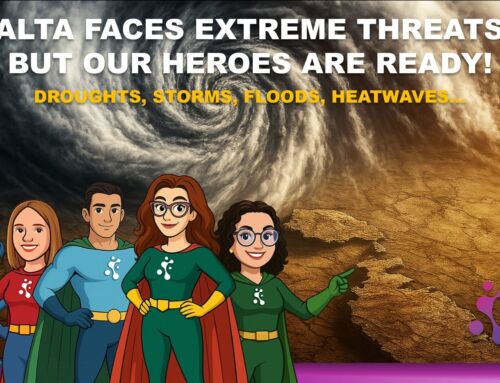In July 2023, Malta found itself in an unprecedented “Cerberus” heatwave. The searing temperatures and stifling humidity disrupted daily life and underscored the profound vulnerabilities posed by extreme heat events in the Mediterranean. This was not an isolated incident but a harbinger of the escalating impacts of climate change, where heatwaves are becoming more frequent, intense, and prolonged.
The heatwave reached record highs, with the Research Innovation Unit recording a staggering 51°C in Triq D’Argens, a remarkable 11°C higher than the neighbouring Wied Għollieqa natural valley. This discrepancy revealed the exacerbating role of the Urban Heat Island (UHI) effect in urbanised areas. As Malta grapples with rising temperatures, the Cerberus heatwave provides an urgent opportunity to reflect, learn, and act on the vulnerabilities and resilience of our public health systems, urban infrastructure, and climate policies.
Heatwave’s Meteorological Overview
Fueled by the El Niño, the Cerberus heatwave was marked by exceptional heat, both in magnitude and duration. A look at the daily maximum temperatures for July reveals that 24 days exceeded the month’s climate norm of 31.7°C. For six consecutive days, the mercury climbed between 40°C and 42.7°C, with the peak recorded on 24 July as the 10-day heatwave reached its zenith. Such temperatures were unprecedented for Malta, reflecting Southern Europe’s growing intensity of heat waves.
In urban areas like Triq D’Argens, temperatures soared even higher. The UHI effect, caused by heat-retaining materials, dense infrastructure, and sparse vegetation, amplified the heat considerably. By contrast, Wied Għollieqa, a neighbouring valley of Triq D’Argens, recorded lower temperatures, demonstrating how land use and green spaces can mitigate heat extremes. These disparities highlight the urgent need for adaptive urban planning.
The Urban Heat Island Effect and Its Role
The temperature gap between Triq D’Argens and Wied Għollieqa vividly illustrates the UHI effect’s influence during the Cerberus heatwave. Urbanised zones, with their asphalt roads, concrete buildings, and limited tree cover, trap heat during the day and release it slowly at night, causing prolonged heat exposure for residents. Our Malta UHI App (https://arcg.is/1LDnHz0) has been instrumental in mapping these temperature variations, offering valuable insights into urban temperature dynamics.
The data recorded during this period emphasised the importance of incorporating green spaces and reflective surfaces in urban design. Expanding vegetation, for instance, reduces ambient temperatures through shading and evapotranspiration. Similarly, adopting lighter-coloured building materials that reflect solar radiation rather than absorb it can significantly alleviate urban heat stress.
Public Health and Societal Impacts
The Cerberus heatwave exacted a grim toll on public health. Superintendent of Public Health Charmaine Gauci reported 80 excess deaths during this period, many among the elderly and those with pre-existing health conditions. Vulnerable groups faced the dual threat of high temperatures and elevated humidity levels, which compounded the physiological strain on their bodies.
Heat stress was particularly severe during peak hours when temperatures exceeded 40°C. Relative humidity during the month remained consistently high, intensifying the heat’s impact. The oppressive weather not only led to fatalities but also strained healthcare services as hospitals and clinics dealt with heatstroke, dehydration, and respiratory issues.
Public health advisories urged residents to stay hydrated, avoid direct sun exposure, and check on vulnerable neighbours. However, the heatwave exposed gaps in preparedness and highlighted the need for a more robust early-warning system and community-based interventions to protect at-risk populations.
Strains on Infrastructure and Resources
Malta’s infrastructure buckled under the heatwave’s demands. The soaring temperatures triggered record electricity consumption, with July 2023 seeing an all-time high of 663 MW. Residents relied heavily on air conditioning, cooling systems, and fans to cope with the extreme heat, causing power outages in several localities. These outages not only disrupted daily life but also placed vulnerable individuals at risk, particularly those dependent on powered medical devices.
The strain on Malta’s energy grid highlighted the urgent need for investment in resilient infrastructure capable of withstanding extreme weather. Transitioning to renewable energy sources and decentralising power systems could enhance stability during periods of high demand. Similarly, improving building insulation and promoting energy-efficient cooling technologies can reduce dependency on electricity during heatwaves.
Climate Change Context and Lessons Learned
The Cerberus heatwave cannot be viewed in isolation. It is part of a broader trend of intensifying extreme weather events fuelled by global warming. The World Meteorological Organization has identified 2023 as the hottest year on record, with global temperatures averaging 1.45°C above pre-industrial levels. These changes align with scientific projections that Mediterranean countries like Malta will experience more frequent and severe heatwaves in the coming decades.
Malta’s vulnerability to climate change demands urgent action. Beyond immediate responses to heatwaves, the nation must address the root causes of global warming. Reducing greenhouse gas emissions through energy efficiency, renewable energy adoption, and sustainable transport is critical. At the same time, adaptation strategies must focus on enhancing resilience to protect both people and ecosystems from the impacts of climate change.
Solutions and Future Preparedness
As Malta reflects on the challenges of the Cerberus heatwave, a multi-faceted approach to climate resilience emerges as imperative. The UHI monitoring app (https://arcg.is/1LDnHz0) is valuable for identifying heat hotspots and guiding targeted interventions. Expanding urban green spaces, such as parks and rooftop gardens, can provide natural cooling and improve air quality.
Hybrid solutions that combine nature-based strategies with geoengineering approaches also hold promise. For instance, installing reflective pavements, cool roofs, shaded walkways, and outdoor cooling systems can help reduce ambient temperatures in urban areas. On a policy level, Malta must implement heatwave action plans that include early-warning systems, public awareness campaigns, and support for vulnerable populations.
Finally, addressing energy resilience is crucial. Investments in renewable energy sources, such as solar and wind, can reduce dependency on fossil fuels and ensure grid stability during periods of high demand. Promoting energy-efficient appliances and retrofitting buildings with heat-resistant materials can also mitigate the impact of future heatwaves.
A way forward
The Cerberus heatwave of July 2023 stands as a stark reminder of the escalating impacts of climate change. Its record-breaking temperatures, public health challenges, and infrastructure strain underscore the urgent need for comprehensive action. For Malta, this means addressing immediate vulnerabilities and embracing long-term solutions that enhance climate resilience.
By investing in sustainable urban planning, adaptive infrastructure, and robust public health systems, Malta can transform the lessons of Cerberus into a blueprint for future preparedness. As the nation confronts the realities of a warming world, collective action spanning individuals, communities, and policymakers will be vital to safeguarding both lives and livelihoods.







